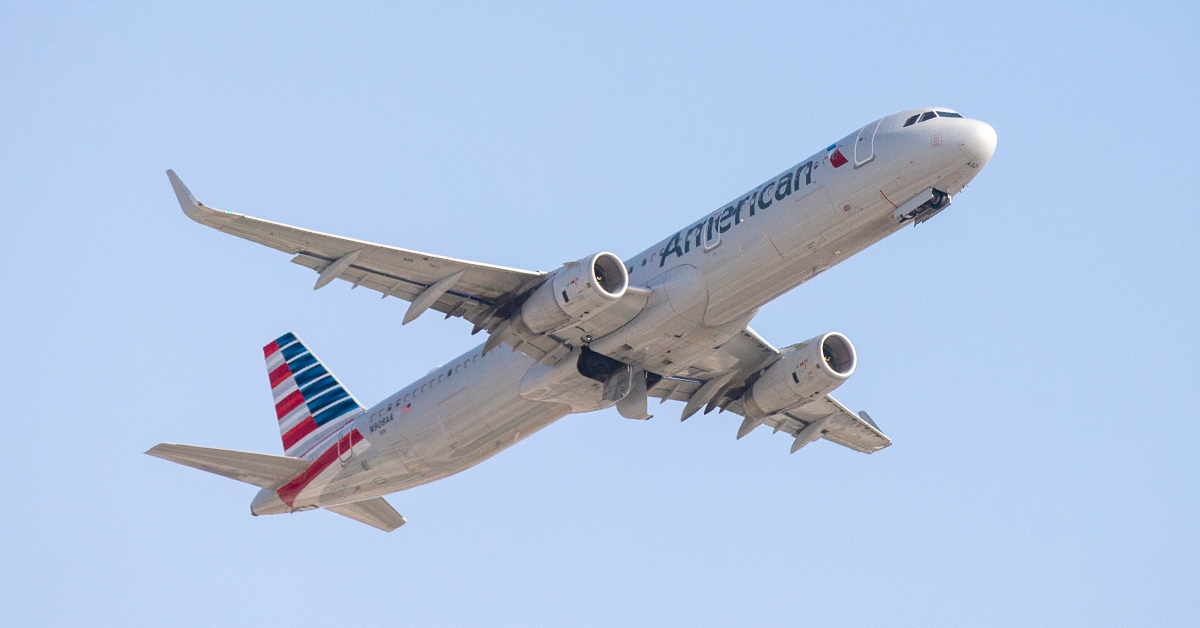
Our resident pilot, 121pilot, offers his commentary on the American Airlines flight 300 incident, a takeoff mishap in 2019 that led to the scrapping of an Airbus A321. A final investigation has now been published, blaming the issue on pilot error. -Matthew Klint, Editor
Airbus Pilot Analysis: American Airlines A321 Takeoff Incident
On April 10, 2019 a dramatic incident occurred involving one of American Airlines’ A321T aircraft where it rolled left on takeoff, impacting a runway sign and damaging the left wing. The 321T is American’s premium transcontinental aircraft equipped with first, business and economy classes. The aircraft did return to New York JFK and land safely, but subsequent evaluation revealed that the impact was hard enough to cause a 6-degree upward bend in the left wing. As a result, the aircraft was determined to be beyond economical repair and subsequently stripped and scrapped.
Recently the National Transportation Safety Board (NTSB) released its final report on the cause of this incident. See below for what I feel is the essence of the report.
There is a lot there, but it can be boiled down pretty simply. After the First Officer called the takeoff decision speed, the Captain for unknown reasons increased his left rudder input from 8⁰ to 25⁰. The airplane responded by turning left towards the edge of the runway. When the Captain rotated the aircraft it began to roll left as well. Both pilots attempted to arrest this roll through full right sidestick but the aircraft continued to roll left ultimately reaching a maximum of 37⁰ before the left wing struck the ground. Shortly after this impact the rudder pedals reached full right and the crew began to recover the aircraft.
From that point on, given what had occurred, I see a pretty normal flight. The Captain was understandably (and by his own admission) pretty shaken up by the event. The airplane was flying normally and they had no cockpit indications of any problems. The crew made a fairly rapid and prudent decision to return to JFK where they landed normally. The Captain made what I see as a very wise call given his state of mind to allow the FO to land the airplane.
The Captain’s State Of Mind
The part of this whole incident that is obviously perplexing is the Captain’s sudden rapid left rudder input at rotation. He’s highly experienced with 25,000 hours total time and some 3,000 hours in the 320 series of which he believed most was in the 321. There was no need for that input and you would have expected that as the airplane started to drift left, he would have automatically corrected for that with right rudder input. Looking at his post event interviews he doesn’t remember making the left rudder input and his startled reaction to the result of that input leaves me thinking that he truly didn’t realize he’d done it. For him, up until that moment, this was an entirely routine flight just like he’d done hundreds of times before.
Based on the NTSB report it looks like both pilots subsequently went through a retraining course and returned to flying. I’m sure that there will be those who think the Captain should have been removed from the cockpit. I would disagree. His career up until that point had been free of any accidents or incidents. He’s a pilot who loves what he does and my strong sense is that he approaches flying as a professional pilot should. I‘m certain after this event and the subsequent training he’s a better pilot today than we was in April of 2019 and I wouldn’t hesitate if I knew who he was to have my family aboard one of his flights.
Sometimes when an event happens, we can look at the crew’s action and discern a reason why they did what they did. This case is frustrating perhaps because we can’t. I suspect the person most haunted by that is the Captain himself because even he has no idea why he did what he did.
Key Section Of NTSB Report
Here’s what I consider the essential snippet from the report:
“According to the digital flight data recorder (DFDR), as the airplane accelerated during the takeoff roll, thrust was applied symmetrically, and no braking asymmetry and nose wheel steering inputs occurred. Left rudder pedal inputs ranged between 0° and 13° as the airplane accelerated, consistent with a right crosswind. The airplane’s heading was 315°. During a postaccident interview, the captain reported that, when he applied left rudder, it felt as if he was using more force with his left leg. The captain further stated that he kept the airplane near the runway centerline and that, when the airplane reached at 80 knots, “everything was ok.” (The CVR recorded the first officer’s 80-knot callout at 2040:13.)
The first officer made the takeoff decision speed (V1) callout at 2040:30, indicating that the airplane had reached 150 knots. According to the captain, sometime between that callout and the first officer’s rotate callout (which occurred less than 2 seconds later to indicate that the airplane had reached 156 knots), the airplane made a “significant” turn to the left. DFDR data showed that, as the airplane accelerated to 156 knots, the captain’s left rudder input increased from about 8° to 25° during a 1.5-second period.
The airplane’s lateral acceleration increased from 0.11 to 0.32 G, and its heading started to veer left of course. The captain then applied full aft sidestick (airplane nose up) and right sidestick up to 16°. At 2040:32, the captain’s sidestick briefly changed from a right to left deflection before changing to the maximum right deflection as the nose landing gear weight-on-wheels parameter switched from ground to air. The rudder was deflected about 20° to the left. As the nose landing gear lifted off the ground, the airplane began to roll to the left.
During a postaccident interview, the captain stated that he was “looking at the runway edge” and knew that he had to get the airplane into the air. The captain also stated that, as he rotated the airplane, it began to roll to the left, so he added right rudder and right aileron.
At 2040:33, both the captain’s and the first officer’s sidesticks moved to the maximum right deflection of 20° when the airplane was in a 3° left roll attitude and had an increasing left roll rate. The CVR recorded “dual input” (an automated alert) at 2040:34, indicating that both the captain and the first officer made sidestick inputs. At that time, the rudder moved through its neutral position as the commanded pitch returned to neutral and the pitch angle reached 10°.
The airplane’s left roll was 26° with an increasing left roll rate as the right main landing gear weight‑on-wheels parameter changed from ground to air. The airplane’s heading was 290°, 25° to the left of the runway centerline. At 2040:35, the left roll reached a maximum of 37°, both sidestick controllers remained at the full right roll command position, and both sidesticks were moved the maximum nose-up position. One second later, the CVR recorded a sound consistent with a wing strike. DFDR data showed that the left aileron moved toward neutral without a corresponding change in the right aileron or sidestick control, consistent with the left aileron moving due to contact with the ground.
The rudder pedals reached their full right position, and the left main landing gear weight-on-wheels parameter transitioned from ground to air as the roll angle began to decrease. As the roll angle decreased toward wings level, the captain made a rudder pedal input to the left and moved his sidestick to its maximum left deflection. At 2040:37, the airplane’s radio altitude was 27 ft, airspeed was 164 knots, and pitch was 20.4°. One second later, the rudder pedal began to move toward neutral, the captain’s sidestick moved to the full right position, and sidestick pitch control moved forward through neutral as the airplane rolled to the left.
At 2040:39, the first officer stated, “I don’t know what’s goin’ on.” The airplane reached a 20° left roll and a maximum pitch angle of 24° at 2040:40. The airplane then rolled back toward wings level, and its pitch angle began decreasing toward 14° during the next 2 seconds as the rudder pedal returned to its neutral position and the sidestick was moved to the maximum left position and then back to the neutral position.
As the airplane’s pitch angle decreased toward 14°, its vertical acceleration decreased to 0.58 G. From 2040:41 to 2040:43, rudder pedal inputs ceased, and the rudder moved back to its neutral position. The captain’s lateral sidestick inputs continued, and the airplane recovered from its previous 20° right roll attitude and climbed normally.”
Questions?
If you have questions about flying or airline operations you can email me at ask121pilot@yahoo.com. I will then respond in my Ask Your Captain column. If you have questions or comments about this specific story, please leave a comment below.
image: American Airlines




Yeah stuff is going to happen, given this guy’s resume it appears he is “senior” which is probably why he doesn’t remember. Mistakes get made everyone is only human but this seems like a good example as to why we do not want the pilot age raised to 67. The older you get some of your abilities start to slip.
The pilot was 58. The current and proposed ages of retirement did not impact this event. There are certainly examples of junior pilots having far worse flight outcomes, Air France 447 for one.
This makes little sense to me. I can’t understand how he doesn’t remember or know why he did it. The only comparable I have in my own life is Kiteboarding or WW kayaking. We make mistakes but typically when under stress or a situation unfolds quickly. Not recognizing a squall line as an example and over powering your kite will lead to a pretty exciting and potentially dangerous situation. However, when this has happened, I knew exactly why it occured and what I did wrong. I didn’t respond by saying, “What just happened? I don’t remember what I did wrong?”
With that if his physicals all showed nothing, his cognitive is fine, and his skills are still there, everyone deserves a second chance. But it still leaves me concerned and confused that he would have no recollection of doing something or know why he did it.
You did not mention the captain’s incredible comments about his usual usage of full rudder inputs, inability to understand gages, talking about covering their .sses etc. Would love to hear your comments about those too. Personally, I would never trust this captain.
The Captain didn’t say he regularly used full controls. He said sometimes he feels like when he does the aircraft doesn’t respond. That’s not entirely out of line given the lag time between control inputs and the control surface responding when you go full deflection in the 320 series.
As to their conversation when the part you reference is taking place as far as they know they haven’t hit anything and nothing is wrong with the aircraft. I don’t find it at all unreasonable then the nature of their conversation.
Re not understanding the gauges that’s also not what he said. He said some times your not sure what the airplane is doing. Which given the way the fly by wire system is a designed in the 320 series isn’t entirely unreasonable.
If that movie with denzel Washington showed anything pilots should have to shoot up some coke before every flight to keep them alert and sharp.
You can blame all airline accidents in christians and their puritanical beliefs with which they torture others.
Is there any video of this event? Seems there’d be something that caught it
What if it was intentional? I know it’s a crazy thought.
There is zero reason to think it was and plenty of reasons to think otherwise.
If this were an intentional act the NTSB would have found evidence of it, and would have never clear the captain for a return to duty.
If this were intentional the captain would have crashed the aircraft not correct the bank angle and together with the first officer essential save the aircraft and everyone onboard.
If it were an intentional act the captain would have never made the decision to immediately return to JFK even though nothing on the flight deck suggested there was a problem after they returned to wings level. And the captain would have never voluntarily turned the controls over to the first officer so he could land the aircraft because the captain realized he was so shaken up that he was in no condition to execute the landing.
We like to hear comments like these, especially these days about what pilots think of the MAX being approved or not. Thanks, Captn.
What does the 737 MAX have to do with an Airbus A321 aircraft?
121Pilot-
What does the “whoop” mean at 20:40:34.3 time stamp?
The CVR transcript doesn’t make that clear and without listening to it I can’t tell.
I am in full agreement. I see no reason to fire the captain. Retraining is enough and not a lot of retraining.
Only took three years for the report to be finalized…
If I were him, I would be having some brain scans to rule out any issues. This can be an early sign of brain cancer amongst others. It really should be part of the annual medical check up, maybe it is? Worrying not to remember.
This happened a couple of years ago.
What is with these “senior” AA Airbus pilots? Whether they are flying the venerable A300 or an A321T, they crank on the rudder with crosswinds and (almost) crash?? AA Airbus training must absolutely s*ck if these senior pilots are clueless about how to fly these planes in a light cross wind. Some one (or several) higher up should be fired… or AA should revert to Boeing only (thought these days, though). What clowns. I am glad I abandoned and took my revenue elsewhere.
What is your view on the cya conversation in the cockpit? That honestly bothered me the most. It sounded like he went back for that reason, so he would have an answer when the fas in the back report the incident. It makes me think he would prioritize cya over safety in other situations…or at least he would have considered not turning back if he thought the fas wouldnt report the incident,
You have to bear in mind that this conversation is taking place very early in the flight and before they have any reason to suspect they have hit anything or have aircraft damage. I don’t see this at all as a decision to prioritize cya over safety because at this point they don’t believe they have a safety issue other than not knowing why the airplane did what it did. The airplane was flying fine and they had no indications of anything wrong. I don’t see any indications of decision making that is being driven by some effort to try and cover up a mistake. What I do see is a series of prudent safety minded decisions from the initial decision to return to the airport to the Captain self assessing and determining that the FO should make the landing.
Don’t forget both of these pilots are LA based and live out there so this was the go home leg which might have influenced their choices. But to their credit it didn’t.
Thanks for that perspective
“ than not knowing why the airplane did what it did.”
Are you kidding me? This “senior” captain almost crashed this airplane by applying excessive rudder, there was nothing wrong with the airplane, this was caused by PILOT INPUT.
The real problem here is that a lot of these Airbus pilots are now flight deck managers, they just rely on automation too much and lose their ability to hand fly the airplane. Regardless of how experienced a pilot may be, if you don’t practice skills, you will lose them.
If this had been caused by a foreign pilot, we would be having a different conversation.
Remember 87% of all crashes are caused by the action of the flight crew.
Can anyone explain why any inappropriate pilot action on this (or any other commercial aircraft) would not be immediately countered acted by the First Officer?
Pilots are a bunch of narcissistic a-holes, who never hesitate to judge their fellow aviators. You guys like to whistle past the grave yard and act like you are incapable of fing up. Karma she can be a bitch guys.